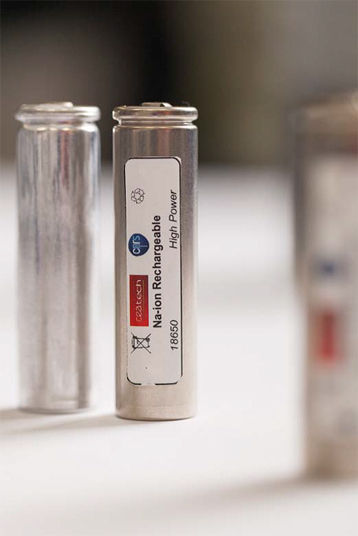Dec
2
French Package a Sodium Battery to Replace Lithium
December 2, 2015 | Leave a Comment
A French team has announced a design and chemistry alternative technology to Lithium-ion for application in specific sectors. The researchers have developed the first battery using sodium ions in the usual “18650” format, an industry standard. The main advantage of the prototype is that it relies on sodium, an element far more abundant and less costly than lithium.

Standard “18650” sodium-ion (Na-ion) batteries, the first-ever in this format. Click image for the largest view. Image Credit: CRNS. Click the Press Release link above for more photos and links to more information.
The French team, mostly including researchers from the CNRS (Délégation Paris Michel-Ange) and CEA within the RS2E network on electrochemical energy storage spent two years on the research. The batteries display performance levels comparable to their lithium counterparts, and the new technology is already attracting industrial interest. The researchers say it could be used to store renewable energies in the future.
The idea for using sodium in batteries dates back to the 1980s. At the time, lithium was preferred to sodium as the material of choice and it has been widely used ever since for portable electronic devices such as tablets, laptops and electric vehicles.
However, lithium has a major drawback in that it is a fairly rare element. Teams from the RS2E (with the CNRS as the leading partner) therefore turned towards sodium, a thousand times more abundant. They developed sodium-ion battery prototypes where sodium ions move from one electrode to another in a liquid during the charge and discharge cycles.
The first step was to find the ideal “recipe” for the positive electrode (cathode) of the battery. Six partner laboratories of the RS2E were involved in the project with the goal to find the right composition for the sodium electrode. The development of a future prototype was then entrusted to CEA, a member of the RS2E network. In only six months, CEA was able to develop the first sodium-ion prototype in the “18650” format, that of the batteries found on the market.
An 18650 format is a cylinder 1.8cm in diameter and 6.5cm in height. The shape should facilitate technology transfer to existing production facilities and product applications. Other international laboratories also work on this technology, but none of them has yet announced the development of such a “18650” prototype.
The second stage made it possible to move from the laboratory scale (synthesis of several grams of cathode material) to the “pre-industrial” scale (synthesis of 1kg batches). It enabled the production of batteries with unmatched power performance levels. This new technology is already showing promising results. Its energy density (the quantity of electricity that can be stored by Kg of battery) amounts to 90Wh/kg, a figure already comparable with the first lithium-ion batteries. And its lifespan-the maximum number of charge/discharge cycles that a battery can withstand without any significant loss of performance exceeds 2,000 cycles.
But most of all, these cells are capable of charging and delivering their energy very rapidly. The main advantage of the technology is that it does away with lithium, a rare element only found in specific locations, as opposed to the sodium circumstances. Its other advantage is financial, as using sodium could make it possible to manufacture much less expensive batteries.
Noticing the similarities with lithium-ion batteries, industrial players have already expressed interest in the technology, notably those who already work in partnership with the RS2E network. The next stage of the project is to optimize and increase the reliability of processes with a view to future commercialization.
The project has given rise to a number of CNRS and CEA academic publications and patents. But the press release hasn’t made any listing or notations to share with you.
The French have a history rich with breakthrough science and there is no reason seen to think this research team’s press work is ahead of the technology. Breaking out with a sodium battery would be quite a boost to a lot of marginal product fields in electric and electronic products that are simply too marginal due to the battery costs.
Even if the low cost isn’t motivator enough, 2000 cycles is a head turner on its own. Lets hope time shows the French effort is the tip of a great iceberg of progress. There are sodium batteries in place now, most the size of small buildings. If the French have a capable battery in the little 18650 format they may just have a major success.

